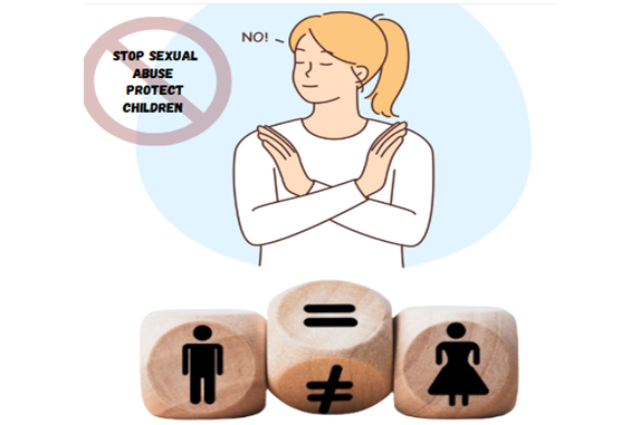
INTRODUCTION
Detriment protection of kiddies or minors is a primary concern for society, and any legal frame needs to be robust. India accepted the Protection of Children from Sexual Offences( POCSO) Act, 2012, as a legal response to the intimidating increase in child sexual abuse cases across the country to cover minors or kiddies against sexual exploitation and abuse. Cases are handled specifically in the( FTSC) Fast Track Trial Courts. The legal laws are designed to have a child-friendly judicial process with the unique requirements of the child victim and speedy delivery of justice. In a technologically advanced world, the protection of children's rights has taken on new confines, particularly concerning digital safety.

WHAT IS POCSO ACT?
To Take Care of Children the Indian Parliament has laid to ordain the Protection Of Children From Sexual Offences Act, 2012 which aims at depleting issues regarding child sexual abuse in India. The act was amended to guard children against sexual abuse and exploitation, covering various offenses like sexual assault, sexual harassment, child pornography, and many child other child offenses. It authorizes mandatory reporting and has established child-friendly courts during legal proceedings. The changes brought in this Act support the act’s thing to expedite Justice, discourage malefactors, and give enhanced protection to children.
Definition of a Child under the POCSO Act
- Section 2(1): A Comprehensive Definition
The POCSO Act defines a "child" as any person below the age of 18 years. This inclusive definition ensures that all minors, regardless of gender, are protected under the Act. It recognizes that both boys and girls can be potential victims of sexual exploitation, highlighting the need for comprehensive protection.
Types of Offenses Under POCSO
- Penetrative Sexual Assault (Section 3): This includes any act of sexual penetration with a child, whether vaginal, anal, or oral. Such offenses are considered severe and have stringent penalties.
- Non-Penetrative Sexual Assault (Section 7): This covers acts like touching or kissing with the intent of committing a sexual offense, though not involving penetration.
- Sexual Harassment (Section 11): This includes actions that force a child into sexual activities, make obscene comments, or expose the child to indecent materials.
- Child Used for Pornographic Purposes (Section 13): The Act criminalizes the making, possessing, and distributing of child pornography, as well as using children in pornographic endeavors.
- Abetment of Sexual Offences (Section 16): The Act provides for prosecuting individuals who aid or abet in the commission of sexual offenses against children. This provision is vital in cases of organized abuse, targeting those who facilitate or encourage such acts.
Child-Friendly Procedures: Special Courts and Child-Friendly Environment
- Section 35: Establishment of Special Courts
The POCSO Act mandates the creation of Special Courts to expedite trials for offenses under the Act. These courts prioritize a child-friendly environment, designed to minimize trauma for the child victim. - Child-Friendly Court Procedures
The Act encourages recording the child's statement in the presence of a trusted individual or counselor. Special measures are in place to ensure that the procedures are as gentle and supportive as possible. - Mandatory Reporting (Section 19)
The POCSO Act places a duty on all individuals, including parents, teachers, and healthcare professionals, to report any suspected instances of child sexual abuse. Failure to report can lead to legal consequences, reinforcing the importance of vigilance in child protection. - Confidentiality of Child's Identity (Section 23)
Anonymity is a critical aspect of the POCSO Act. The child's identity must not be disclosed at any stage of the legal process, thereby preventing stigma and ensuring the child is protected from judgment by society. - Child-Friendly Investigation and Trial Procedures
The POCSO Act emphasizes a child-sensitive investigative approach. A child may be accompanied by a guardian or counselor during questioning, providing emotional support. Investigations should be completed within two months, and trials should conclude within a year of charge framing. This helps mitigate further trauma that prolonged legal proceedings often cause.
Why is POCSO Relevant in the Digital Age?
With the rise of the internet and digital media, children are being increasingly exposed to online pitfalls. The digital footmark of children can make them susceptible to importunity, fixing, and exploitation. These technologies can help identify and report cases of abuse instantly. In the digital age, the Protection of Children from Sexual Offences( POCSO) Act has become more critical than ever as children face adding online. The obscurity of the internet makes it easier for malefactors to target minors, making it essential for legal fabrics to acclimatize. The POCSO Act addresses these issues by furnishing comprehensive delineations for online offenses like child pornography and exploitation, while also calling the reporting of suspected abuse. Technology plays a vital part in guarding children through AI-driven content temperance, online reporting tools, and educational programs on online safety. By combining these technological advances with the legal protections of the POCSO Act, we can produce a safer digital terrain for children, ensuring they're shielded from exploitation and abuse.
CASE
- Just Rights For Children Alliance vs S. Harish (2024)
The Supreme Court's recent ruling in the Just Rights for Children Alliance case has highlighted the urgent need to protect children from the growing dangers of online exploitation and abuse. The decision reinforces the importance of the POCSO Act and Section 67B of the Information Technology Act in combating child sexual exploitative and abusive material (CSEAM), making the creation, possession, and distribution of such content an offense. The Court's interpretation aims to prevent the spread of online abuse at its earliest stages, emphasizing that any form of child exploitation, including through digital means, is unacceptable. Furthermore, the case raises concerns about the broader issue of online pornography, urging a re-evaluation of the 'community standard test' used to determine obscenity. It calls for stricter regulations and greater accountability from digital intermediaries to prevent the widespread availability of harmful content. In this context, laws like POCSO and the IT Act play a critical role in safeguarding human dignity and ensuring the well-being of children and women in the digital age.
Conclusion
The Protection of Children from Sexual Offences( POCSO) Act, 2012, stands as a pivotal legal frame aimed at securing the rights of minors in India. In the digital age, where children are decreasingly vulnerable to online exploitation, the applicability of the POCSO Act has grown indeed more critical. Parents, preceptors, healthcare professionals, and digital platforms must play an active part in the protection of children, working together to produce a safer terrain. As we navigate the complications of the digital age, the POCSO Act remains a vital tool in ensuring that children's rights are upheld, and their safety is prioritized in both the physical and virtual worlds.
REFERENCES
- P. Rahul Ambedkar, Protection of Children from Sexual Offences Act, 2012 – An Overview, IJCRT, available at
- The Protection of Children from Sexual Offences Act, No. 32 of 2012, §§ 3, 7, 9, 11, 13, 16, India, available at
- Protection of Children from Sexual Offences Act, No. 32 of 2012 (India).
- https://indiankanoon.org
